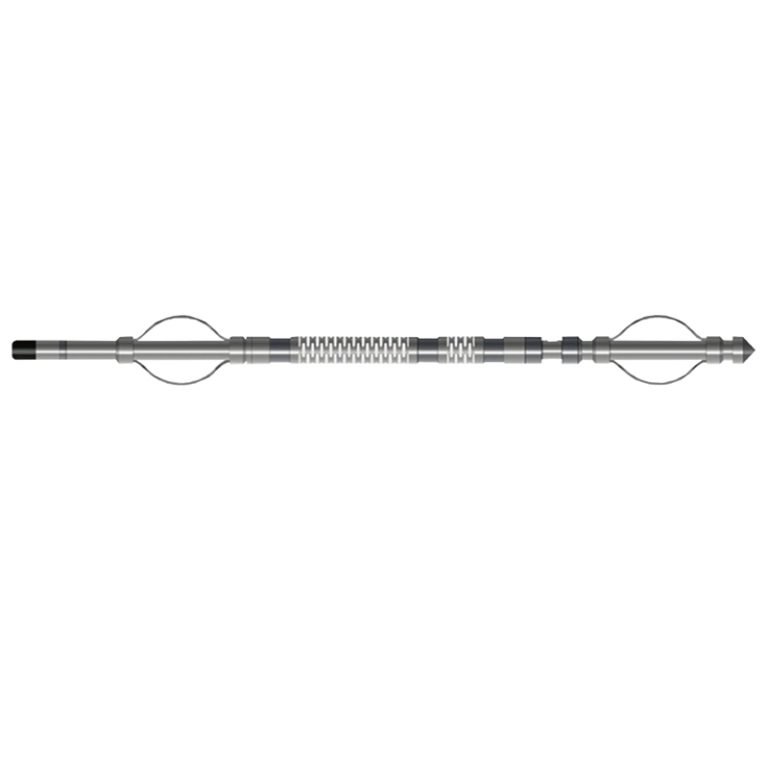Welcome to Geotech!

LDP-1 Litho Density Probe
PRODUCT PARAMETERS
- Small diameter and lightweight instrument, suitable for use in small borehole drilling.
- Spectrum stabilization is achieved by real-time temperature compensation and monitoring the count rate of the high energy peak symmetry channel, and the analysis is achieved by linear matrix least squares method
- The method of simultaneous measurement of long and short source distance detectors can compensate for unfavorable factors such as mud cake.
Description
 Abstract
Abstract
LDP-1 Litho Density Probe is an improvement and extension of density logging. In addition to recording the density of rocks, it also measures the photoelectric absorption cross-section index Pe of the formation, which is related to the lithology. During logging, the instrument records the higher energy part and the lower energy part of the scattered y-ray respectively. The intensity of the scattered y-ray in the high energy part depends on the density; the low energy part is mainly related to the lithology and also to the density, and pe can be obtained after processing.

 Applicable Conditions
Applicable Conditions
● Case
● Bare hole fill with water or mud
● Bare Dry hole
 Applications
Applications
● Evaluation of complex rocky oil -containing gas layers
● Identification of rocky and clay type
● Quantitative calculation of the original strata density
● Research phase change and deposition environment
● Measuring strata porosity degree
 Features
Features
● Small diameter and lightweight instrument, suitable for use in small borehole drilling.
● Spectrum stabilization is achieved by real-time temperature compensation and monitoring the count rate of the high energy peak symmetry channel, and the analysis is achieved by linear matrix least squares method
● The method of simultaneous measurement of long and short source distance detectors can compensate for unfavorable factors such as mud cake.
 Specifications
Specifications
| Natural gamma detector | NAL crystal+photoelectric pipe |
| Radiation source | CS137, 3700MBq |
| Quantitative parameters and range | Natural Gamma: 1 ~ 32768cps, Sccuracy: 5%F.S; Density 1.3 ~ 3.0g/cm3, Accuracy: ± 0.025g/cm3; Pe: 0 ~ 20, Pe: ± 0.2B/e (1.3 ~ 6B/e) |
| Signal output | Bipolar encoding |
FAQ
① In SI, it is m·s-2, and one percent of it is the international unit abbreviation g.u.;
② Conversion between SI and CGS: 1g.u.=10-1 mGal
Gravitational field: The space around the earth with gravity is called the gravitational field.
Gravitational potential: The gravitational potential W in the gravitational field is equal to the work done by a particle of unit mass moving from infinity to that point.
① The normal gravity field of the earth: Assuming that the earth is a rotating ellipsoid (reference plane), the surface is glossy, the internal density is uniform, or it is distributed in concentric layers, the density of each layer is uniform, and the deviation of the shape of the ellipsoid from the geoid is very small, then the gravity field generated by the earth is the normal gravity field.
② The normal gravity value is only related to the latitude, the smallest at the equator and the largest at the poles, with a difference of about 50,000 g.u.; the rate of change of the normal gravity value with latitude is the largest at 45° latitude, and zero at the equator and the poles; the normal gravity value decreases with increasing altitude, and its rate of change is -3.086 g.u.. The main feature of the long-term change is the "westward drift" of the geomagnetic elements, both the dipole field and the non-dipole field drift westward, and have a global nature.
The gravitational field strength is equal to the gravitational acceleration in both numerical and dimensional terms, and the two are in the same direction. In gravity exploration, all references to gravity refer to gravitational acceleration. The gravitational field strength at a point in space is equal to the gravitational acceleration at that point.
Gravity exploration is an exploration method that is based on the density difference of rocks and ores. Since density difference will cause local changes in the normal gravity field of the earth (i.e. gravity anomaly), it is used to solve geological problems by observing and studying gravity anomalies.
-1.png)








